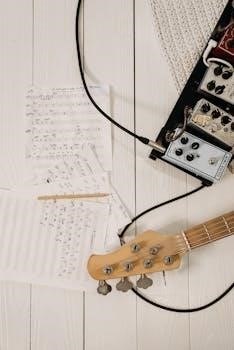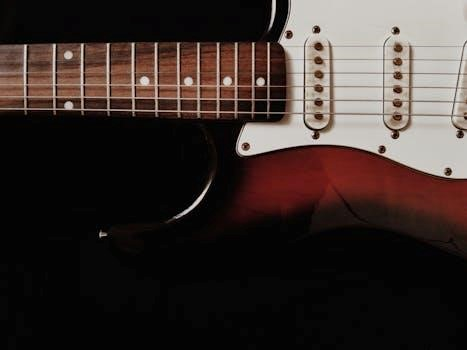Guitar Chords PDF⁚ A Comprehensive Guide
Unlock your musical potential with our comprehensive guide to guitar chords PDFs! This resource provides essential tools for beginners and advanced players alike, offering printable charts and templates to expand your chord vocabulary and create stunning chord progressions with ease.
Embark on your guitar journey with an understanding of guitar chord charts, essential tools for visualizing and learning chords. These charts serve as roadmaps, guiding your fingers to the correct positions on the fretboard to produce harmonious sounds. Whether you’re a beginner strumming basic chords or an experienced player exploring advanced voicings, chord charts are invaluable resources.
A guitar chord chart is a diagram that represents the fretboard of a guitar, typically showing the first few frets. The vertical lines represent the strings, and the horizontal lines represent the frets. Dots or numbers on the chart indicate where to place your fingers to form a specific chord. An “X” above a string means that string should not be played, while an “O” indicates an open string.
Understanding how to read these diagrams is crucial for learning new chords efficiently. Chord charts are available in various formats, including printable PDFs and online resources, making them accessible for practice anywhere, anytime. By mastering the basics of reading chord charts, you’ll unlock a world of musical possibilities and accelerate your progress as a guitarist.
Why Use a Guitar Chord Chart?
Guitar chord charts are indispensable tools for guitarists of all levels, offering numerous benefits that enhance learning and playing. For beginners, chord charts provide a visual guide to finger placement, simplifying the process of forming basic chords like G, C, D, and E. This visual aid helps develop muscle memory and accelerates the learning curve, allowing beginners to quickly play simple songs and chord progressions.
Intermediate and advanced players also benefit from chord charts. These charts can introduce new chord voicings, inversions, and complex chord shapes that expand their musical vocabulary. Chord charts are particularly useful for learning chords in different keys and exploring various musical styles. Furthermore, chord charts serve as a quick reference during practice and performance, ensuring accuracy and efficiency.

The portability of guitar chord charts, especially in PDF format, allows guitarists to carry a wealth of information in their pocket. Whether practicing at home, jamming with friends, or performing on stage, a readily available chord chart can be a lifesaver. In essence, guitar chord charts empower guitarists to learn, explore, and perform with confidence.
Basic Guitar Chords for Beginners
Embarking on your guitar journey starts with mastering a set of fundamental chords that form the backbone of countless songs. These basic chords, often referred to as “cowboy chords,” are typically played in the open position, utilizing open strings to create rich and resonant sounds. Mastering these chords provides a solid foundation for learning more complex chord shapes and musical pieces.
The essential beginner chords include E major, A major, D major, C major, G major, and their minor counterparts, E minor and A minor. These chords are relatively easy to finger and provide a versatile palette for playing various musical styles. Start by practicing each chord individually, focusing on achieving a clean and clear sound without any buzzing or muted strings. Consistent practice is key to developing the finger strength and dexterity required to switch smoothly between chords.

Once you’re comfortable with individual chords, begin practicing simple chord progressions. Common progressions like G-C-D or E-A-B7 are excellent starting points. Use a metronome to develop a steady rhythm and gradually increase the tempo as your accuracy improves. With dedication and patience, these basic chords will become second nature, opening up a world of musical possibilities.
Reading Guitar Chord Diagrams
Guitar chord diagrams are visual representations of the guitar fretboard, providing a clear and concise way to understand how to form chords. Learning to read these diagrams is crucial for any aspiring guitarist. A typical chord diagram depicts the six strings of the guitar as vertical lines, with the thickest line on the left representing the lowest (6th) string and the thinnest line on the right representing the highest (1st) string.
Horizontal lines represent the frets on the guitar. The top line of the diagram usually indicates the nut of the guitar (the point where the strings pass from the headstock to the fretboard). Numbers may appear next to the strings, indicating which fingers to use⁚ 1 for index, 2 for middle, 3 for ring, and 4 for pinky. An “X” above a string means that the string should not be played, while an “O” indicates that the string should be played open (without pressing down on any frets).
Dots on the diagram show where to place your fingers on the fretboard. The position of the dot indicates the fret and string you should press down on. Understanding these elements allows you to quickly interpret chord diagrams and accurately form chords on your guitar. Practice reading diagrams regularly to enhance your understanding and expand your chord knowledge.
Essential Open Position Chords
Open position chords are fundamental for beginner guitarists, providing a foundation for learning more complex chords and songs. These chords are called “open” because they utilize open strings, which contribute to their rich and resonant sound. Mastering these chords will allow you to play a vast array of songs and develop your musical skills.
Some of the most essential open position chords include E major, A major, D major, C major, G major, and their minor counterparts, such as E minor and A minor. The E major chord, for instance, involves using all six strings and creates a full, vibrant sound. A major is another crucial chord, often used in countless popular songs. D major is known for its bright and cheerful tone, while C major provides a solid foundation for many chord progressions.
G major is also a staple, frequently used in combination with other major and minor chords. These chords not only sound great on their own but also form the basis for numerous chord progressions. Practice transitioning smoothly between these chords to enhance your playing ability and expand your repertoire. Remember to focus on clean finger placement and consistent strumming for the best sound.
Major Chord Shapes
Understanding major chord shapes is essential for any guitarist looking to expand their musical vocabulary. Major chords generally have a bright and uplifting sound, making them fundamental building blocks for countless songs across various genres. These chords are constructed using a specific pattern of intervals⁚ the root, a major third, and a perfect fifth.
The most common major chord shapes include open position chords like C, G, D, A, and E. These chords are often the first ones that beginner guitarists learn due to their relative simplicity and versatility. By mastering these open chord shapes, you can play a wide range of songs and start to understand how chords fit together in progressions.
Beyond open position chords, movable major chord shapes, often based on barre chords, allow you to play major chords in any key. The E shape and A shape barre chords are particularly useful. By understanding the root note of the chord and positioning the barre accordingly, you can easily play any major chord up and down the fretboard. Regular practice of these shapes will improve your finger strength and dexterity, ultimately enhancing your overall guitar playing skills.
Minor Chord Shapes
Minor chord shapes are just as crucial as major chords for any guitarist aiming to create diverse and expressive music. Unlike the bright and cheerful sound of major chords, minor chords evoke feelings of sadness, melancholy, or introspection. They’re built using a root, a minor third, and a perfect fifth interval, giving them their characteristic darker tone.
Beginners often start with open position minor chords like Am, Em, and Dm. These shapes are relatively easy to learn and are frequently used in popular songs. Mastering these chords will open up a new world of musical possibilities, allowing you to add depth and emotion to your playing.
Similar to major chords, minor chords also have movable shapes based on barre chords. The E minor shape and A minor shape are especially useful. These shapes allow you to play minor chords in any key by simply sliding the barre up or down the fretboard. Practicing these movable shapes will not only expand your chord vocabulary but also improve your fretboard knowledge and finger strength. Experimenting with different minor chord shapes will greatly enhance your ability to create compelling and emotional music.

7th Chord Variations
Seventh chord variations add a layer of complexity and richness to your guitar playing, moving beyond basic major and minor chords. These chords are built by adding a seventh interval to a triad, creating a fuller, more colorful sound. Mastering 7th chord variations is essential for playing genres like blues, jazz, and funk, but they can also add a unique flavor to rock and pop music;
The most common 7th chord variations include dominant 7th (7), major 7th (maj7), and minor 7th (m7) chords. Dominant 7th chords have a bluesy, slightly dissonant sound, often used to create tension and anticipation in a chord progression. Major 7th chords offer a sophisticated, jazzy feel, while minor 7th chords add a touch of melancholy.
Experimenting with different 7th chord voicings can greatly enhance your playing. Try using different inversions, which involve changing the order of the notes in the chord. You can also explore adding extensions like 9ths, 11ths, and 13ths to further enrich the sound. Learning 7th chord variations will unlock new creative possibilities and elevate your guitar playing to a new level of sophistication.
Free Printable Guitar Chord Charts Online
The internet is a treasure trove of resources for guitarists, and free printable guitar chord charts are among the most valuable. These charts offer a convenient way to learn and reference various chords, making them an indispensable tool for beginners and experienced players alike. Whether you’re looking for basic open chords or more advanced voicings, you can find a wealth of printable charts online.
Many websites offer downloadable PDF charts that cover a wide range of chords, including major, minor, dominant, and 7th chords. Some charts are designed specifically for beginners, featuring essential chords and easy-to-read diagrams. Others cater to more advanced players, providing comprehensive collections of chord variations and voicings.
When searching for free printable guitar chord charts, consider the layout and clarity of the diagrams. Look for charts that are well-organized, easy to read, and include helpful information such as finger placements and string names. With the right chart, you can quickly learn new chords, expand your musical vocabulary, and take your guitar playing to the next level. Remember to always respect the terms of use of the website providing the resource.
Blank Guitar Chord Chart Templates
For guitarists seeking personalized learning and creative exploration, blank guitar chord chart templates are an invaluable resource. These templates provide a framework for documenting and organizing chord voicings, fingerings, and musical ideas, tailored to individual needs and preferences. Whether you’re a student, teacher, or songwriter, blank chord charts empower you to customize your learning experience and unlock new musical possibilities.
These templates often feature a series of blank fretboard diagrams, allowing you to visually represent chord shapes and finger placements. You can use these diagrams to record new chords you learn, experiment with different voicings, or create your own unique chord progressions. Some templates also include staff paper for notating melodies and harmonies, enabling you to integrate chords into complete musical compositions.
Blank guitar chord chart templates are readily available online as printable PDFs. They come in various layouts and designs, catering to different skill levels and musical styles. You can find templates with multiple chord diagrams per page, templates with larger diagrams for detailed notation, and templates designed for specific tunings or instruments. With the right blank chord chart template, you can transform your practice sessions into focused explorations and unleash your creative potential.

How to Use Chord Charts in Practice
Guitar chord charts are powerful tools, but their effectiveness hinges on how you integrate them into your practice routine. Don’t just passively look at the diagrams; actively engage with them to maximize your learning. Start by familiarizing yourself with the chart’s layout and symbols. Understand what each line and dot represents, and how they correspond to the guitar’s fretboard.
Begin by practicing individual chords. Focus on accuracy and clarity, ensuring each note rings out cleanly. Use the chord chart as a reference, but try to memorize the finger placements and transitions between chords. As you become more comfortable, gradually increase your speed and fluidity.
Next, incorporate the chords into simple exercises and songs. Look for songs that use the chords you’re learning, or create your own chord progressions. Pay attention to the transitions between chords, and practice smooth, efficient movements. Use a metronome to develop your timing and rhythm. Experiment with different strumming patterns and fingerpicking techniques to add variety to your playing.
Finally, use chord charts to explore new musical styles and genres. Challenge yourself to learn chords and songs outside your comfort zone. The more you experiment, the more versatile and creative you’ll become as a guitarist. Remember, chord charts are a guide, not a crutch. Use them to expand your knowledge and skills, and let your musicality shine.
Creating Simple Chord Progressions
Crafting chord progressions is the heart of songwriting and guitar playing. Start with basic major and minor chords from your chord chart PDF. A common starting point is the I-IV-V progression in a major key. For instance, in the key of G, this would be G-C-D. Experiment with the order and repetition of these chords to find a sequence that sounds pleasing to your ear.
Once you’re comfortable with the I-IV-V, explore adding the vi (minor) chord; In G major, this is Em. A progression like G-D-Em-C is widely used and versatile. Try transposing these progressions to other keys using your chord chart as a guide.
Incorporate 7th chords for added flavor. Substitute a dominant 7th (like G7) for a standard major chord to create a bluesy feel. Minor 7th chords (like Am7) can add a touch of melancholy. Experiment with inversions (different voicings of the same chord) to create smoother transitions between chords.
Use your ear as your ultimate guide. Don’t be afraid to break the rules and try unexpected chord combinations. Pay attention to how the chords make you feel, and let your emotions guide your creative process. The goal is to create a progression that is both musically interesting and emotionally resonant.
Advanced Chord Shapes and Voicings
Moving beyond basic open chords opens up a world of sonic possibilities on the guitar. Advanced chord shapes, often involving barre chords and altered tunings, provide richer harmonic textures and greater flexibility on the fretboard. Explore different inversions of familiar chords to create smoother voice leading and more interesting sonic landscapes.
Voicings refer to the specific arrangement of notes within a chord. Experiment with different voicings to create different moods and textures. Close voicings, where the notes are clustered together, tend to sound more compact and focused, while open voicings, where the notes are spread out, can create a wider, more spacious sound.
Altered tunings, such as Drop D or Open G, allow for unique chord voicings and easier access to certain chords. These tunings can inspire new chord progressions and melodic ideas. Experiment with different tunings to find ones that suit your musical style and preferences.
Understanding chord theory is crucial for exploring advanced shapes and voicings. Learn about intervals, chord construction, and harmonic relationships to unlock the secrets of the fretboard. With a solid understanding of theory, you can create your own unique chord voicings and arrangements.

